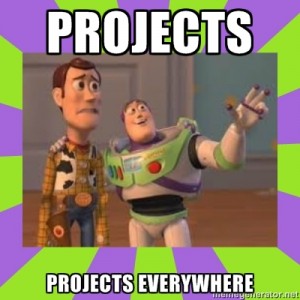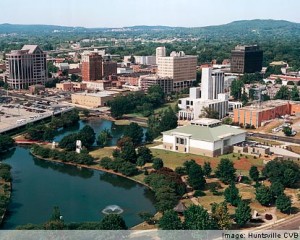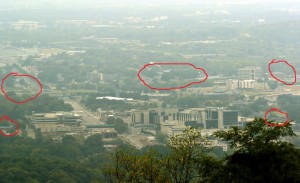If one were to search for pictures of Huntsville, it is likely that one would find old colonial homes and vistas of Great Springs, a natural waterway that runs through the city. These pictures are beautiful despite the implications of their brutal past. They are also carefully shot to avoid the lower income areas of the community. Speaking from experience, one would have to search thoroughly to find any pictures of the true face of Huntsville: the projects. I spent a week in Huntsville, Alabama at the end of this summer, and no matter where I went I was always within sight of a project. By a “project” I mean a grouping of low-cost, government-built housing units (government housing projects). These are typically single-story dwellings made of red brick and economy building materials. They are usually two room homes or apartments, sharing a common green area with multiple other buildings.They are hideous from an aesthetic viewpoint and when considering the basic living standards of fellow human beings.
This is an official picture of Huntsville. It looks pretty:
It may seem suspicious to anyone googling pictures of Huntsville that there are no official panoramic views of the downtown core. It should; pictures of Huntsville are small boxes, capturing only one angle, because otherwise the constant ghetto would be visible. This is the view of downtown from the missing angle (sorry about the mist; it is extremely humid there). This is the reality of Huntsville. This is a picture I found outside the official register; the red circles were made by me, and they denote government housing projects:
The projects of Huntsville were designed and built under the guidance of the US government, and in this respect showcase a failing in urban and social planning. In terms of practical planning, Huntsville’s projects are spread out and visible throughout the city. Why are there projects and ghettos all over the city of Huntsville? The answer is complex, but briefly put, the rich people live outside of the city. NASA runs a rocket engineering facility and arsenal outside of town, which is a massive economic boon for Huntsville. But the middle and upper class people who work there don’t want to live in or near projects, so they built their homes in the hills around the city. The projects remain due to legislation and land prices, and Huntsville continues to be covered in ineffectual and unappealing housing. For someone doubting the necessity of proper urban planning, one trip to Huntsville will change his or her mind.
What is actually most strange about the layout of Huntsville is the juxtaposition of man-made monstrosities, and natural elegance and beauty. Tall old-growth trees make beautiful canopies across all but the widest of streets and freeways. The rolling hills erupt with yellow and red leaves as early as the first day of September. It is a tragic mash-up of town and country. Huntsville is the deformed child of Ebenezer Howard’s Garden City.
Also, this happened in Huntsville: famous on the internet.




I have never been to Huntsville, Alabama, but I find it kind of funny that you negatively described one of my favourite things about a city: the mixture of man-made monstrosities and natural beauty. My favourite road in Kelowna is Maple St, which is a hidden pocket of trees that canopy over the houses and road. I also have a vivid memory of running along the seawall in Vancouver and my breath was taken by the forest on one side, the ocean on the other, and a man-made path that allowed me to enjoy these incredible views but still be within city limits.
Maybe I have to see it to fully agree or disagree with you on Huntsville in particular, but personally, I love the congregation of town and country.
It’s a shame you missed last Tuesday’s class, Andrew, because we were in fact discussing the projects – namely, Jane Jacobs on why they are such failures – in the broader context of the successes and failures of the Athens Charter.
I agree that it can be a shame that the downtown core of a city is surrounded by projects, or unsafe areas, thereby persuading people to abandon these areas. All I can honestly think of is East Hastings in Vancouver which has spread into Gastown, but rather than actually attempting to reform this part of Vancouver they instead try to centralize them (the crazies) to one area and prevent the problem from spreading. Do you think if the laws changed and there was a sufficient effort implemented to improve these projects would the safety of these areas change for the better or worse? My fear is that by dispersing these people to other areas, albeit ostracizing them from the city center, wouldn’t benefit anyone and realistically would only cause problems in the new areas and therefore only spread the problems brought by projects. Do you have any possible solutions or are they best left alone and centralized to one location?
I have never been to Alabama or Huntsville but your post leaves a very negative view of projects and thus on the city. My question to you is as to what you feel would be a better option for low cost, government subsidized housing? Or if you fell that it is not necessary at all?
The necessity for a low cost option requires in our current system and economy for the buildings to be built on the cheap. I am sure that everyone would love to build the projects with the love and care that was put into the old colonial homes of which you speak, but that is just not really economically possible and thus the projects become monstrosities. I don’t have an answer at all to this question, I was just wondering your thoughts.
I don’t really think I am in a place to really introduce or create a successful alternative at the moment, so let me instead expand on why I think the projects are so ineffective. They remind me of Miliutin’s criticism of the Garden City, in that they are evil utopias, which dampen the effect of capitalism to the extent that the city is a livable place without the depravity required to incite revolution. The projects are hideous and vile. They pay lip service to the everyday need for housing, and even offer a mutilated amount of green space for their residents. They also make life just bearable enough for those living within their walls to continue on without seriously objecting to the quality of life the projects offer.
I could argue in their stead some sort of apartment complex, but the tenement blocks of the UK come to mind as an immediate example of that kind of structure’s failings. What is probably needed is the marriage of urban planning and mass social change. There are problems in Western society that defy minor physical solutions, such as the projects. Without social equality community housing projects only lead to ghettos. Classism seems to go hand in hand with capitalism, and until everyone allowed access to the same opportunities, low-cost housing is only a thin mask over the real problem.
Do I have a concrete solution? Not really, but I know what the problem is, and that it is being ignored because it is convenient.
You might find the case of New Belgrade interesting, because it supports your point that if you introduce social equality (even an imperfect version of it) then it changes the equation. In spite of its flaws, most of New Belgrade was (and is) successful and appreciated by its inhabitants.
I have somewhat of a solution. Jobs. Better paying jobs and affordable childcare. Plus programs that save people’s money from jobs, and apply them to affordable down payment towards home ownership programs. That’s just my little two cents, and a drop in the bucket towards what really and exactly needed. Thanks for listening.
May I take a stab at your question. Subsidized housing never works, it works no where. Projects become high cost slums because governments are incapable of running a business. Its confiscates from the productive to subsidize projects, like a projects but still runs out of money because government is worse mismanagement organization ever invented.
This is such a disgrace to the beautiful town of Huntsville. I really wish people would understand how wonderful Alabama truly is.
You are wrong that most people live outside the city, and that NASA is outside the city. Huntsville is huge; many of the people who work at NASA and in Research Park (defense industry and aerospace companies) live in southeast Huntsville, a mostly middle-class area that extends to the Tennessee River. Monte Sano (the hills you mentioned, part of Huntsville) does have a few developments for the wealthy. There are many new apartment complexes and condominiums downtown and nearby, expensive, yes. Next to one of the “project” areas is one of the largest alternative arts centers in the region, a re-purposed industrial site, Lowe Mill Arts & Entertainment. When I pass through the “project” areas, to get to Lowe Mill, I see people sitting on their steps, playing in their yards, grilling food, hanging laundry, riding bicycles, living a family life. This housing may not have been perfectly conceived, but it is often more functional and conducive to community than the new condominium buildings. Generations have grown up there. Unfortunately, some of the “projects” downtown were removed to make way for the condominiums, and an historic black school was almost completely destroyed. People were kicked out, after having considered it their neighborhood for years. There were churches and businesses there that served that community. That was wrong. In my opinion, the ugliest thing about Huntsville’s main drags (University Drive, Memorial Parkway, Governor’s Drive) is the commercial litter: fly-by-night businesses, signs, billboards, trash–not the “projects.” I live in the Five Points area of Huntsville, which is northeast of the downtown area. It has some nice old craft-style bungalows from the 1930s and 1940s, but further northeast, the houses get smaller and less well-kept. This is the “hippie” area. There is likely a drug problem a few blocks north of me, but my street seems OK. The diversity of people living in this area is great, and Five Points itself has some funky, fun shops. Huntsville did not do a very good job of desegregation, and is still working on it. Perhaps the “projects” contribute to that, but they need to remain until a better solution is found. Perhaps they could be repurposed into student housing, since students can rarely afford the going rate, and there’s a state university and a few colleges around here. Again, my view is that the commercial sprawl in Huntsville is uglier than the “projects” by far.
I totally agree with Mrs. Coffey. Well said! Hunstville is a family city. The only thing that really needs major attention is the homelessness. I pray that people would come together to change the narrative.